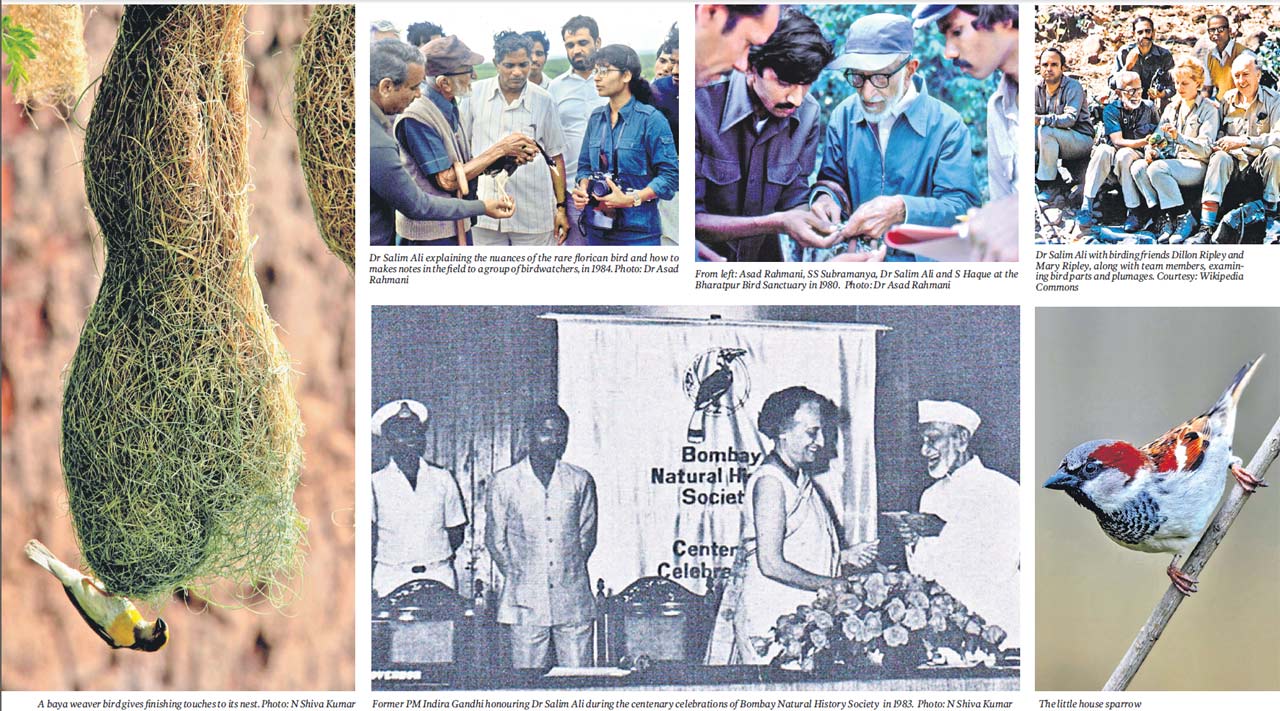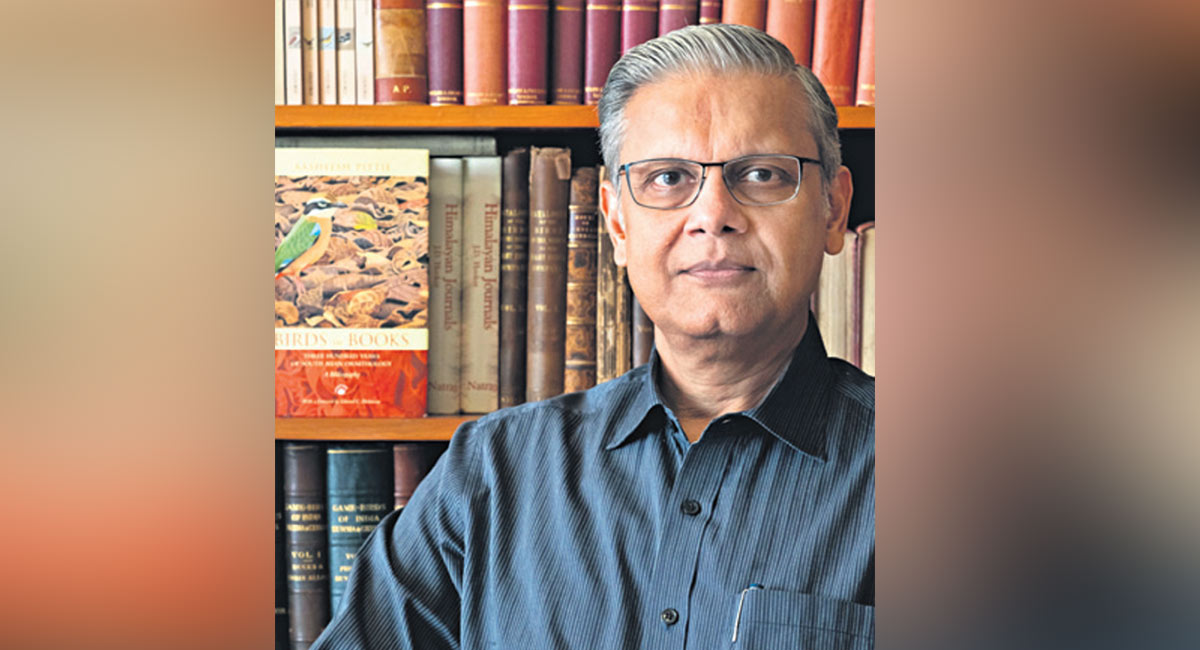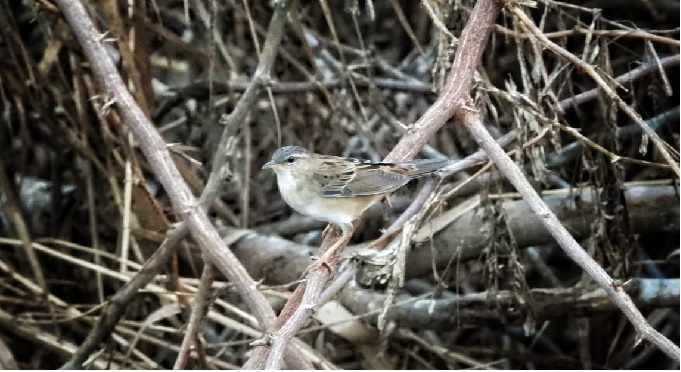Rewind: The Call of the Sparrow
The efforts of Dr Salim Ali, fondly known as ‘Birdman of India’, to preserve bird habitats became crucial in an era when industrialisation and urbanisation posed severe threats to biodiversity

By N Shiva Kumar
Dr Salim Ali, fondly known as the ‘Birdman of India’, revolutionised ornithology by popularising bird watching with his landmark book, The Book of Indian Birds (1941). His rigorous fieldwork and insightful research earned him a reputation as one of the world’s foremost ornithologists. Pioneers like Ali and earlier British naturalists made ornithology in India a household name by blending traditional knowledge with scientific consistency. Born on November 12, 1896, Ali’s legacy endures, especially on his birth anniversary — a time to celebrate his dedication to documenting and demystifying ornithology.
Many of us, particularly those born during or before the 1990s in India, are familiar with the little house sparrows. They were once so abundant that they were considered a naughty nuisance, but not treated as pestering pests. I recall how my mother had me sit on guard on the roof of our house to keep off sparrow’s folks from gobbling up rice, wheat, grains or homemade fryums left out to sun-dry. I used to allow a few sparrows to feed for a couple of minutes before making them scoot and scatter. Acting as a ‘scarecrow’ for my mom encouraged me to learn how to capture these perky birds, even with just a 50mm lens on my Japanese Chinon camera in 1987. It was in the same year DrSalim Ali passed away at the age of 91 years. Fortunately, he completed his inspirational autobiography The Fall of a Sparrow.
The Book of Indian Birds, published in 1941, was a landmark in making birdwatching. Written in simple language, it introduced the layperson to Indian birds and sparked national interest in birdwatching and conservation
In the last 25 years, the population of house sparrows has declined significantly, so much so that many city-born youngsters under 20 may have never seen one. Many of us do not realise that there are nine species of sparrows in India, of the 26 worldwide, and they all look almost similar from a distance. But observing them with binoculars or a long camera lens reveals their distinct features, not only in plumage but also in the subtle visible differences between males and females of the same species.
Feathered with Curiosity
One of these sparrow species fascinated young Salim. As a boy, he was captivated by the boisterous birds in his neighbourhoods. His curiosity found an outlet when he shot a sparrow with his airgun — a moment that would change his life. The bird had a yellow streak on its throat, unlike the sparrows he usually shot down to study. Instead of dismissing this divergent encounter, he turned to his uncle, a natural history enthusiast. His uncle introduced him to WS Millard, honorary secretary of the Bombay Natural History Society (BNHS), one of India’s oldest scientific organisations, founded in 1883.
Millard not only identified the bird as a yellow-throated sparrow but also introduced young Salim to the world of ornithology. He was even shown the extensive and valuable collections of avian specimens in Asia. The society preserves over 30,000 stuffed birds (taxidermy mounts) along with tagged specimens. Each specimen has a tag detailing species, date, location and collector, providing essential data for research. This single encounter ignited a lifelong passion for birds in Ali. Yet, despite these formative experiences, his journey was riddled with obstacles.
Sparrow as a Protagonist
Another sparrow-like bird that fascinated Ali was the baya weaver. He encountered them during their breeding season, and their intricately woven nests intrigued him. Ali began what he calls “the longest and unbroken opportunity for research”. He later published a paper on the “nesting habits of the baya weaver bird,” which gained international acclaim for its comprehensiveness. Ali discovered how the energetic male baya bird makes multiple nests and entices the females one after the other to select him as a boyfriend. Once lovemaking is over, he plays almost no part in raising the family, instead goes on to pursue another girlfriend after offering a newly built nest. These love affairs continue until there are no more females left to lure for producing progeny.
One of Salim Ali’s first breakthroughs was a mega project involving a field survey of the princely state of Hyderabad Deccan, commissioned by the Nizam of Hyderabad in 1931 which cemented his status as India’s foremost ornithologist
Ali’s life story reads like a fabulous fantasy turned into a legacy of fortitude — a romantic tale of a young boy enchanted by Nature who grew into a man whose passion redefined India’s view of birds. Born 128 years ago in Bombay, Ali’s academic path was unconventional. The youngest of nine children, he lost his parents young and his future seemed uncertain. Yet, birds, which fascinated him since childhood, became his salvation and, ultimately, his legacy.
During the grand centenary celebrations of the BNHS in 1983, former Prime Minister Indira Gandhi remarked, “For 50 years, Salim Ali has been the doyen of wildlife conservationists in the country. He is responsible for the new consciousness sweeping the nation. He may be the oldest member of the society, but there are very few as young at heart or as energetic.” During these celebrations, Ali was also fittingly honoured and regarded as synonymous with the BNHS. He was described not just as an individual but as an institution in his own right — one that could be trusted implicitly.
“Salim Ali has been the doyen of wildlife conservationists in the country. He is responsible for the new consciousness sweeping the nation,” said Indira Gandhi, Former Prime Minister
Ali’s work was not limited to the study of birds. He was a fervent advocate for the conservation of India’s wildlife, and his efforts to preserve bird habitats became crucial in an era when industrialisation and urbanisation posed severe threats to biodiversity. Ali fought against the destruction of forests, wetlands and other critical ecosystems. It is not usually known how he used his close rapport with Prime Minister Jawaharlal Nehru to help protect the Bharatpur Bird Sanctuary in Rajasthan. Ali appealed directly to Nehru, emphasising the ecological and scientific significance of Bharatpur jungles as a haven for migratory birds, one of the most famous bird reserves in the world.
Struggles and Determination
Despite facing significant hardships in his early years, Ali’s passion for birds drove him to pursue knowledge beyond conventional avenues. He trained in ornithology at the Zoological Museum in Berlin to refine his expertise, but when he returned, he encountered limited career opportunities in India. Joining the BNHS in 1930 marked a turning point. From there, his career blossomed.
One of the first breakthroughs was a mega project involving a field survey of the princely State of Hyderabad Deccan, commissioned by the Nizam of Hyderabad in 1931. Ali’s genius shone through as he traversed uncharted landscapes on foot, by bullock cart, and on horseback with his team and paraphernalia of tents. Over the years, he catalogued species, mapped habitats and studied behaviours, leading to the discovery of several bird species and cementing his status as India’s foremost ornithologist.
Systemic Bird Surveys
Similarly in the 1930s, Ali conducted numerous pioneering bird surveys across India with the assistance of rulers of princely States. Other major State surveys conducted were the Survey of Cochin and Travancore (1933-1935), the Survey of Central India (1935), the Survey of Western India (1937-1939) — covering Gujarat, Rajasthan and parts of Maharashtra, and the Survey of Kashmir and Ladakh (1938), a unique survey in the high-altitude environment.
These surveys laid the foundation for scientific ornithology in India, introducing systematic data collection and emphasising conservation issues. His work culminated in influential publications, including The Book of Indian Birds, his first book,and several research articles that shaped Indian bird conservation for decades to follow.
Tantalising Tomes
The Book of Indian Birds was written in simple language, and introduced the layperson to Indian birds, sparking national interest in bird watching and conservation. Ali was not only a field specialist negotiating landscapes with ease but also a prolific writer. He also published works like Birds of Kutch (1945), Indian Hill Birds (1949), and Birds of Travancore and Cochin(1953) apart from scientific papers. In the Mishmi hills of the Northeast in 1948, Ali and his fellow birder Dillon Ripley decided to write the now-famous Handbook of the Birds of India.
Dr Asad Rahmani, former BNHS director, reflects, “Before the Handbook of the Birds of India was published in ten volumes from 1968 to 1974, most Indian bird books were written in formal, matter-of-fact English. Ali changed this with engaging, descriptive language.” Rahmani shares Ali’s depiction of the House Crow: “A confirmed commensal of man… very useful as a municipal scavenger and indispensable ally to neglected or incompetent sanitary administration! Inquisitive, intelligent and impudently familiar, yet excessively wary and alert all the time, possessing an uncanny capacity for scenting and avoiding danger and distinguishing a harmless human from one not to be trusted.Gregarious, sociable, clannish, cunning, and omnivorous — other essential qualifications for successful co-existence with man.” Ali’s books are full of such vivid descriptions.
Fifty years down the line, the Handbook of the Birds of India remains irreplaceable despite updates in taxonomy. Unfortunately, many young birdwatchers overlook it, missing its unique insights, Rahmani notes with regret. Ali received numerous honours, including the Padma Bhushan and Padma Vibhushan. However, his true legacy lies in the widespread recognition of birds as a crucial part of India’s natural heritage and how they are key indicators of environmental integrity and ecological balance.
(The author is an independent journalist and documentary wildlife photographer)
Related News
-
Cartoon Today on December 25, 2024
2 hours ago -
Sandhya Theatre stampede case: Allu Arjun questioned for 3 hours by Chikkadpallly police
2 hours ago -
Telangana: TRSMA pitches for 15% school fee hike and Right to Fee Collection Act
2 hours ago -
Former Home Secretary Ajay Kumar Bhalla appointed Manipur Governor, Kerala Governor shifted to Bihar
2 hours ago -
Hyderabad: Organs of 74-year-old man donated as part of Jeevandan
2 hours ago -
Opinion: The China factor in India-Nepal relations
3 hours ago -
Editorial: Modi’s Kuwait outreach
3 hours ago -
Telangana HC suspends orders against KCR and Harish Rao
4 hours ago


